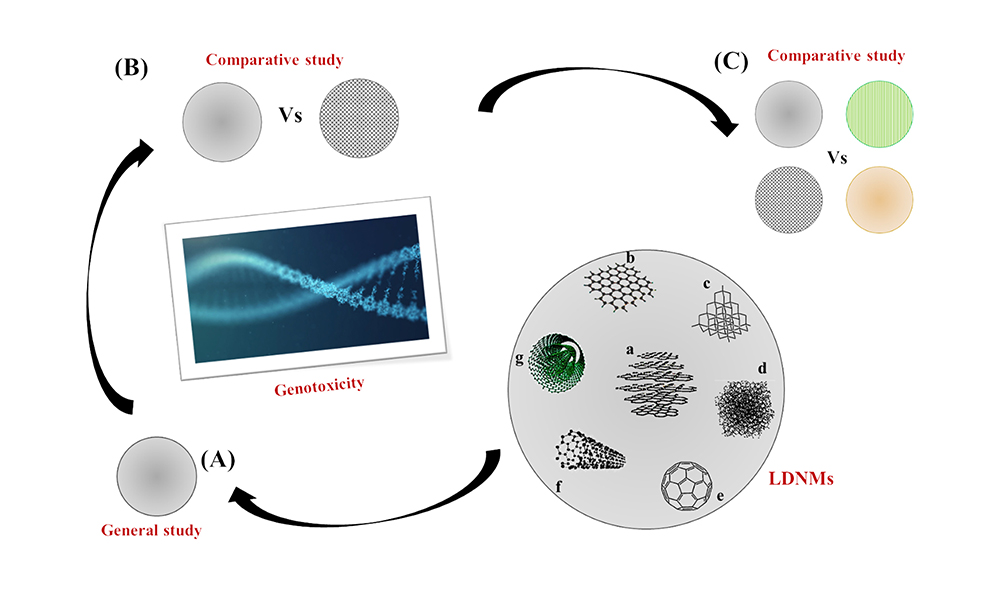- 작성일
- 2021.04.12
- 수정일
- 2021.04.12
- 작성자
- 김은희
- 조회수
- 412
[2021.02.26] 한동욱 교수님, 저차원 나노물질의 잠재적 위해성을 다룬 총설 논문 발표

광메카트로닉스공학과 한동욱 교수 연구팀이 생체 내에서 저차원 나노물질에 의한 유전독성(Genotoxicity) 유발 가능성을 다룬 총설 논문을 발표했다.
‘저차원 나노물질(Low dimensional nanomaterials)’은 고차원 나노물질에 비해 부피 대 표면적이 더 크고 양자 구속 효과를 나타내기 때문에 전 세계 관련 연구자들 사이에서 주목을 받고 있으며, 생체영상, 나노바이오센서, 약물전달, 암치료 및 화장품 등과 같은 많은 유용한 생체의학적 활용성을 지니고 있다.
그러나 이를 생산하는 공장이나 합성하는 실험실에 장기간 노출되면 세포독성, 발암성 및 유전독성의 부작용을 유발해 생명을 위협하게 된다. 여러 독성 중 유전독성은 특히 선천적 장애와 악성 종양을 유발하는 DNA 관련 이상을 후대에게 물려 줄 위험성 때문에 가장 중요하게 고려돼야 한다.
한동욱 교수 연구팀은 나노물질의 독성 연구가 본격화되기 시작한 2005년 이후 발표된 저차원 나노물질의 유전독성 관련 연구 논문과 참고문헌 250여 편을 토대로 1) 유전독성의 유형, 메커니즘(발생 기작), 검출법 및 영향 요인, 2) 저차원 나노물질의 종류(탄소, 금속, 세라믹)와 크기 및 농도와 노출 시간에 따른 유전독성, 3) 동일한 유형 및 서로 다른 유형의 저차원 나노물질 간 유전독성 정도 비교, 4) 유전독성 연구의 중요성, 해당 분야의 인식, 향후 해결 과제 및 지침에 대해 정리했다.

<저자: 왼쪽부터 한동욱 교수, IS Raja 박사, 이종호 박사, 홍석원 교수, 신동명 교수>
한동욱 교수는 저차원 나노물질의 유전독성 연구의 중요성에 대해 “미세먼지(PM10)는 입자의 크기가 지름 10㎛ 이하인 대기오염 물질로서 입춘이 지난 요즘 일기예보의 단골손님이고, 그 위해성이 매우 심각하여 ‘침묵의 살인자’라 불리고 있다. 그런데, 저차원 나노물질의 경우 심지어 초미세먼지(PM2.5, 입자 크기 2.5㎛ 이하) 보다 100~1000배 더 작아서 그 크기가 불과 수십㎚~수㎚에 지나지 않는다”고 말하며 해당 분야의 인식 개선이 필요하다고 지적했다.
한 교수는 이와 관련해 “아직까지 저차원 나노물질의 독성에 대하여 충분한 연구가 이뤄지지 않아서 과학적 근거자료가 다른 독성물질에 비해 상당히 부족하기 때문에 향후 나노물질로 인한 질병 유발 기전과 상관성 규명 및 생물학적 상호작용에 대한 시뮬레이션 연구 등에 대한 정부와 민간 차원의 지속적 연구비 지원이 필요할 것이며, 또한 다학제적 융합연구를 통한 실험동물 대체 독성시험법 확립 및 친환경적 나노물질 제조, 보관, 폐기 등과 관련된 지침 마련이 시급하다”고 강조했다.
이 총설 논문은 나노물질 응용 연구 분야의 세계적 석학인 호주 퀸즐랜드대학의 유스케 야마우치(Yusuke Yamauchi) 교수가 주관한 특별호(Nanoarchitectured Materials)에 초청받아 『Journal of Hazardous Materials』 1월 8일 온라인판에 게재됐으며, 5월호 출판을 앞두고 있다.
- 논문 제목: A critical review on genotoxicity potential of low dimensional nanomaterials
- 논문 링크: https://doi.org/10.1016/j.jhazmat.2020.124915
이번 연구는 과학기술정보통신부·한국연구재단 기초연구실지원사업의 지원으로 수행됐으며, 광메카트로닉스공학과 한동욱 교수가 교신저자, BIT융합기술연구소 셀레스틴 라자(Iruthayapandi Selestin Raja) 박사후연구원과 ㈜다안코리아 연구팀장 이종호 박사(나노메디컬공학과 2010년 졸업)가 공동 제1저자, 광메카트로닉스공학과 홍석원 교수와 홍콩대 기계공학과 신동명 교수(나노과학기술학부 2009년 졸업)가 공동저자로 참여했다.
* 그림 설명(상단): 저차원 나노물질에 대한 유전독성 비교 연구의 분류: (A) 비교 없이 개별 나노물질에 대한 일반적인 연구, (B) 유사한 유형의 나노물질 간의 유전독성 비교 연구, (C) 크기, 모양, 전하, 표면 개질 등과 같은 다양한 매개 변수에 따른 다양한 유형의 나노물질 간의 유전독성 비교 연구
[Summary of Research]
A research team led by professor Dong-Wook Han in the Department of Cogno-Mechatronics Engineering at Pusan National University (PNU) has compiled a comparative study on the genotoxicity of the same or different kinds of low-dimensional nanomaterials (LDNMs) with the classification of genotoxicity, mechanism, assessment, and affecting factors, highlighted the importance of studying the genotoxicity of LDNMs, and signified the perceptions, future challenges, and possible directives in the field. This study has begun since Professor Han was invited to contribute a paper to a special issue (Nanoarchitectured Materials) of the Journal of Hazardous Materials edited by Professor Yusuke Yamauchi (University of Queensland, Australia), a world-renowned scholar in the field of nanomaterial applications in July 2020. Professor Han's research team conducted extensive research and analysis of about 250 research papers and references related to the genotoxicity of LDNMs published since 2005, when the toxicity studies of nanomaterials began in earnest.
This review paper was online published in the Journal Hazardous Materials (IF = 9.038, the top 3.02% rank in a category by the Journal Citation Reports (JCR)) on 8 January 2021 by professors of the Department of Cogno-Mechatronics Engineering, Suck Won Hong and Dong-Wook Han, a postdoctoral researcher of BIO-IT Foundry Technology Institute at PNU, Iruthayapandi Selestin Raja, and three others at Daan Korea Corporation, The University of Hong Kong, and Gachon University, which is scheduled to be offline published in May 2021. This work was supported by Basic Research Laboratory Program through the National Research Foundation of Korea (NRF) grant funded by the Korea government (MSIT).
* Figure
Schematic demonstration of genotoxicity of low dimensional nanomaterials (LDNMs). A general study on individual LDNMs without comparison (A), a comparative study on genotoxicity between similar type of LDNMs (B), and a comparative study on genotoxic potential among different types of LDNMs (C) with respect to different parameters such as size, shape, charge, surface modification, etc.
(2021.2.26.)
- 첨부파일
- 첨부파일이(가) 없습니다.
 광메카트로닉스
광메카트로닉스